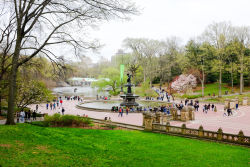Central Park
View all monuments in NYC Parks, as well as temporary public art installations on our NYC Public Art Map and Guide.
Robert Burns
| Artist: | Sir John Steell |
| Dedicated: | October 2, 1880 |
| Location: | South end of Literary Walk |
Artwork History
This statue of Scottish national poet Robert Burns (1759–1796), companion to the 1872 Sir Walter Scott (1771–1832) sculpture across Literary Walk, is by Sir John Steell (1804–1891), and was dedicated in 1880.
Burns was born in Alloway, Ayrshire, the son of a tenant farmer. His father died in 1784, and Burns became head of the household, but he had already started writing poetry. On July 3, 1786, he published his Poems, Chiefly in a Scottish Dialect, in nearby Kilmarnock, to enormous success in both countryside and city. Burns left his farm for Edinburgh on November 27, 1786, but the fame and attention he received there put him ill at ease; he never found a comfortable place in contemporary society’s class distinctions.
Poems earned Burns fame in his lifetime, but little money. He published a second, enlarged, edition in Edinburgh in 1787, but by the summer of 1788 had taken up tenant farming again, in Ellisland, Dumfriesshire, where he struggled. He kept up an active literary and intellectual life, and obtained a post in the excise service in 1789. He moved to Dumfries in 1791, and lived there until his death on July 21, 1796, of chronic rheumatic heart disease.
Burns is a national hero. Known affectionately as “Rabbie,” his works are unmatched by any other Scottish artist as a source of national pride. His birthday, January 25 (“Burns Night”), is celebrated throughout the country and by Scots and admirers around the world with a banquet - a haggis (a Scottish delicacy made from calf or sheep organ meat boiled in the stomach of the animal) as the centerpiece, ceremoniously addressed with Burns’s odes to haggis and whisky before being served.
Burns’ genius was his poetic use of the rhythms and dialects of everyday speech, and it was his personal mission to revive traditional Scottish song. He traveled the country, collecting tunes, airs, fragments of expressions and songs, and created songs whole, even writing words to folk tunes which had never had lyrics. He captured something of the Scottish spirit which has endured, and each generation has claimed him again as its own, even as Scotland has struggled in a search for identity. He is credited with “Auld Lang Syne”, and his best-known poems include “Scots, Wha Hae,” “Tam O’Shanter,” and “To a Mouse.”
Not long after the unveiling of Sir Walter Scott in 1872, a committee formed to erect a monument to Burns. A year later, specifying only the material and colossal size, it selected the same sculptor, John Steell, to create Scott’s bronze counterpart. Steell was born in Aberdeen, the son of a wood carver, and studied at the Trustees Academy, and in Rome. He became a member of The Royal Scottish Academy, and in 1838 was appointed Sculptor of the Queen of Scotland, producing numerous public and private art commissions, and managing a foundry, which introduced the art of bronze casting to Scotland.
Steell’s melodramatic conception depicts Burns seated on a tree stump, quill pen in hand, eyes turned heavenward in a pose of inspiration. At his feet is a poem dedicated to his lost love, Mary Campbell, and a plough alluding to his agrarian origins. The sculpture was unveiled on October 3, 1880, and the ceremony was attended by 5,000 people, area Caledonian clubs in full Highland dress, and 100 distinguished guests, with music by Grafulla’s Band.
Wallace Bruce wrote “Walter Scott’s Greeting to Robert Burns,” whose first lines read: “We greet you Rabbie here tonight; Beneath these stars so pure and bright; we greet you, Poet, come at last; With Will [Shakespeare] and me your lot to cast.” Robert Burns also joined the 1876 statue of American poet Fitz-Greene Halleck (1790-1867), whose 1822 poem “Burns” read in part, “But what to them the sculptor’s art; His funeral columns, wreaths and urns? Wear they not graven on the heart, the name of Robert Burns.”
In 1940, NYC Parks’ monuments crew reconstructed the statue’s unstable pedestal. It was rebuilt again in 1993; the quill, missing, was replicated; and the sculpture conserved through the Adopt-A-Monument Program, a joint venture of the Municipal Art Society, NYC Parks and the New York City Art Commission (now the Public Design Commission). The restoration was funded by the Saint Andrew’s Society, which established a fund for ongoing care. On October 26, 1996, hundreds gathered here for the bicentennial of Burns’ death; world-renowned folk singer Jean Redpath performed, and the event was supported by the Burns Society of the City of New York, the American-Scottish Foundation, the St. Andrew’s Society of the State of New York, the New Caledonian Club, and Scottish Heritage USA.
Artwork Details
| Description: | Seated figure (over life-size) with scroll and plough at feet, on pedestal |
| Materials: | Figure--bronze; Pedestal--brick core topped and faced with granite |
| Dimensions: | H: 14'10" W: 10' D: 10' |
| Donor: | Scottish-Americans |
| Cast: | ca. 1880 |
Inscription
1) scroll at figure's feet: [ part of "To Mary in Heaven"]2) pedestal front: "ROBERT BURNS"
3) pedestal rear: " PRESENTED / TO THE / CITY OF NEW YORK / BY ADMIRERS OF / SCOTIA'S PEASANT BARD / ON THE 121st ANNIVERSARY / OF HIS BIRTH."
Please note, the NAME field includes a primary designation as well as alternate namingsoften in common or popular usage. The DEDICATED field refers to the most recent dedication, most often, butnot necessarily the original dedication date. If the monument did not have a formal dedication, the yearlisted reflects the date of installation.
For more information, please contact Art & Antiquities at (212) 360-8163.
Check out your park's Vital Signs
Clean & Safe
Green & Resilient
Empowered & Engaged Users
Share your feedback or learn more about how this park is part of a
Vital Park System

Know Before You Go
Anticipated Completion: Spring 2024
Anticipated Completion: Spring 2025

Contacts
Central Park Information: (212) 310-6600
Central Park Information (for the Hearing Impaired): (800) 281-5722
Belvedere Castle, The Henry Luce Nature Observatory: (212) 772-0210
The Charles A. Dana Discovery Center: (212) 860-1370
The Dairy Visitor Center and Gift Shop: (212) 794-6564
North Meadow Recreation Center: (212) 348-4867
Loeb Boathouse (Bike rentals, boat rentals & gondolas): (212) 517-2233
Carousel: (212) 879-0244
Fishing at Harlem Meer (Catch & Release): (212) 860-1370
Harlem Meer Performance Festival: (212) 860-1370
Horseback Riding - Claremont Stables: (212) 724-5100
Metropolitan Opera (Performances on the Great Lawn): (212) 362-6000
New York Philharmonic (Performances on the Great Lawn): (212) 875-5709
Shakespeare in the Park - The Public Theater at the Delacorte Theater: (212) 539-8655
Central Park SummerStage: (212) 360-2777
Swedish Cottage Marionette Theater: (212) 988-9093
Tennis: (212) 280-0205
Weddings, Ceremonies and Photography at the Conservatory Garden: (212) 360-2766
Wildlife Center & Tisch Children's Zoo: (212) 439-6500












